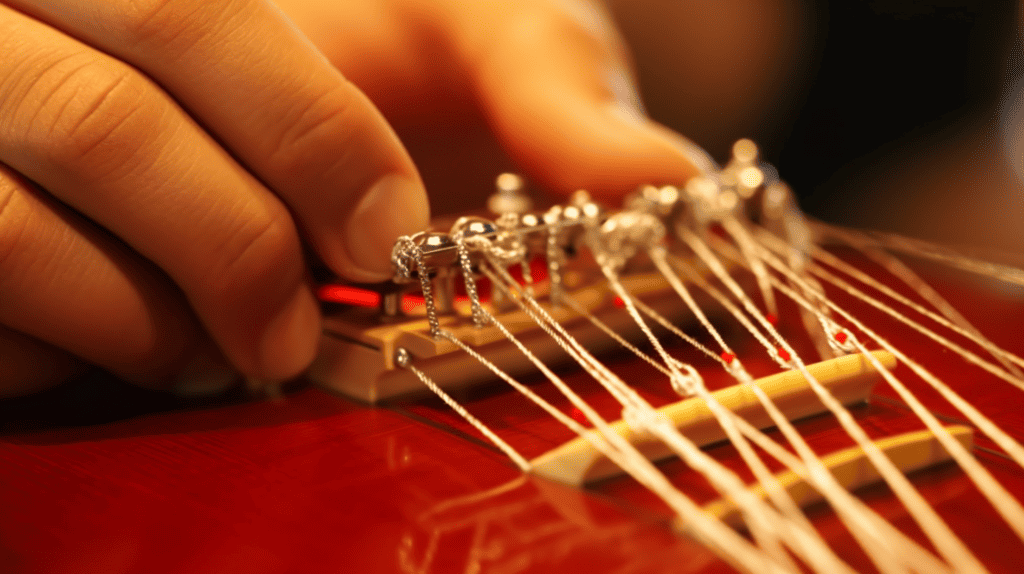Greetings, fellow guitar players and enthusiasts! Today, I’m going to share with you an essential part of guitar maintenance – the art of cutting guitar strings. You’ll not only learn how to cut guitar strings, but also how to do it without wire cutters, and the right length to cut your guitar strings. So, let’s strum our way into it, shall we?
The Tools and the Rules – Your Guide to Cutting Guitar Strings

So, you’ve decided to restring your cherished six-string, and you’re standing there, new pack of guitar strings in hand, pondering what comes next. The first lesson to keep in mind is that you need to cut guitar strings. Why, you might ask? Well, those excess string lengths won’t only hamper your playing, but they could even be a safety hazard if you’re not careful! Alright, I’m exaggerating a bit, but remember, safety first, folks!
A pair of wire cutters or dedicated guitar string cutters is your best tool in this process. But what if you’re caught without wire cutters? Don’t fret (pun intended), there are other ways. We’ll delve into those shortly.
First, let’s walk through the steps of how to cut guitar strings with wire cutters or guitar string cutters:
- Remove the old strings: Loosen each guitar string by turning the tuning peg until the string tension is low enough to remove. Then, unwind the string from the tuning peg and pull it out from the bridge.
- String up the new strings: Insert the new string through the bridge and pull it towards the guitar’s headstock. Align the hole in the tuning peg with the neck and thread the string through the hole.
- Wind it up: Start turning the tuning peg to wind the string, ensuring it winds from the inside out. It’s crucial to maintain string tension as you wind it.
- Cut the string: Once the string is sufficiently tight, you can cut off the excess string. A good rule of thumb is to cut about two tuning pegs’ worth of string beyond where it’s attached. This will leave enough string for the guitar strings to settle and stretch without becoming loose.
Making the Cut Without Wire Cutters

So, you’re missing wire cutters. Well, don’t worry, you’re not condemned to play a guitar with spiky strings shooting off in all directions! There are a few methods you can use to cut guitar strings without wire cutters. I wouldn’t exactly call these the guitar tech’s standard, but hey, sometimes you have to do what you got to do with the tools you have!
- The ‘Bend and Twist’ method: This technique requires no tools. You simply bend the string back and forth at the point where you want to cut it. Keep bending until the string breaks – but do be careful, those broken ends can be sharp!
- The ‘Pliers’ method: If you have a set of ordinary pliers or needle nose pliers, these can double as string cutters in a pinch. Just grip the string where you want to cut it and twist it until the string breaks.
- The ‘Scissors’ method: This one requires heavy-duty scissors or even a sharp knife. Don’t use your everyday kitchen scissors as you might end up with a ruined pair of scissors and an uncut string.
Remember, these methods to cut guitar strings without wire cutters should only be used in a pinch. A good pair of dedicated wire cutters or guitar string cutters is worth the investment for any serious guitar player.
Knowing the Length – When and Where to Cut Guitar Strings
As a beginner in the world of guitar maintenance, you might be wondering – how long should you cut your guitar strings? The answer to this, much like a catchy tune, has been playing on repeat for as long as guitars with steel strings have existed! The right length to cut your guitar strings largely depends on the type of guitar you’re playing and how many wraps you want around the machine heads.
When dealing with a steel-string acoustic or electric guitar, leaving about 2-2.5 inches (around 5-6 cm) past the tuning post is usually the sweet spot. However, if you’re tuning a classical guitar, you’ll want to leave a bit more, as these strings are often tied on.
To Cut or Not to Cut Guitar Strings
Now, I can almost hear the wheels turning in some of your heads. “Is cutting guitar strings really that necessary? Can’t I just let my freshly strung guitar flaunt its excess string ends?” Well, my fellow guitar enthusiasts, you certainly can. But like a complex chord progression, there are pros and cons to this approach.
On the upside, leaving your guitar strings uncut can bestow your instrument with a certain “carefree” rockstar vibe. Plus, the extra string length can be used to make minor adjustments if your string tension feels too tight or loose. There’s also a certain level of satisfaction seeing your guitar adorned with new strings, their ends spiraling around the tuning posts like metallic spaghetti.
However, the downside to leaving strings without wire cutters running their course is the potential hazards. Those extra inches of string could pose a risk, from poking you in the eye to snagging on your clothes. Plus, let’s be honest, it can look a bit untidy. And if there’s one thing we guitar players love, it’s a clean, well-organized setup.
And remember our band comrades. You know that drummer who keeps pilfering your picks? Well, an uncut G-string can transform into a very efficient tripwire. But perhaps that’s a pro rather than a con. I’ll leave that decision in your capable hands.
A Few Handy Tips for the Guitar Player

We’ve talked about the pros and cons of cutting your guitar strings and the importance of having the right tools like string cutters or, in a pinch, a pair of pliers or even nail clippers. Now, let’s share a few handy tips that’ll make your guitar maintenance and string cutting journey smoother than a Carlos Santana solo.
Tip Number One: Safety First with Guitar Strings: Always – and I mean, ALWAYS – slacken your strings before you cut them. There’s nothing quite like the startling ‘PING’ of a prematurely cut string, not to mention the risk of a high-velocity string-end shooting across the room. Trust me, your cat, your roommate, or your significant other won’t be impressed! If you’re cutting guitar strings without wire cutters, the same rule applies – safety first.
Tip Number Two: Measure Twice, Cut Once: Be careful with how short you cut your strings. Cutting them too short can make restringing a nerve-wracking game of ‘will-it-or-won’t-it reach the tuning peg’. On the flip side, too long and you risk looking like you’ve got a mini antenna farm sprouting from your guitar headstock. My rule of thumb? Leave about an inch and a half to two inches. That’s enough for a few windings around the tuning peg and a neat appearance.
Tip Number Three: Keep a Firm Grip: While cutting, especially if you’re not using a dedicated wire cutter, keep a firm grip on the string end you’re about to cut. The last thing you want is for it to go flying across the room. You’ll either lose it completely (the number of guitar strings swallowed by living room carpets is truly tragic) or worse, step on it later. Trust me, stepping on a Lego brick has nothing on stepping on a discarded string end!
Tip Number Four: Different Strings, Different Approaches: Did you know that your approach to cutting guitar strings could differ based on the type of string? For instance, nylon strings (usually found on classical guitars) are generally easier to cut and less likely to ping off dangerously if accidentally cut under tension. On the other hand, steel strings (used in acoustic and electric guitars) require a bit more caution due to their higher string tension and potential to cause injury if mishandled.
Tip Number Five: Anticipate the Sharp Ends: When cutting guitar strings, especially the wound ones, the remaining end might curl or bend due to the release of tension. This might seem trivial, but these small curled ends can be pretty sharp! To avoid any potential injuries, try to anticipate the direction of this curl and keep your fingers clear.
Tip Number Six: Regular Guitar Maintenance: If you’re changing and cutting strings regularly, it might be a good opportunity to give your fretboard a once-over. Removing the strings gives you an unobstructed view of your fretboard, allowing you to check for any signs of wear or damage. Regular maintenance goes a long way in extending the life of your guitar.
Conclusion: Guitar String Maintenance is a Key Part of Your Musical Journey
So there you have it, the insider’s perspective on how to cut guitar strings, even when you find yourself without the standard tool, a wire cutter. Rest assured, it’s not an insurmountable task, but one that requires mindful attention to prevent the dreaded string snap-back injuries or accidentally causing damage to your instrument. Always remember the golden rule: slacken those strings first, then carefully make your cut.
As long as you keep safety at the forefront of your practices, you’ll be swapping out those old strings for a freshly strung guitar that resounds with vibrant melodies in no time. And remember, the road to guitar mastery is paved with these small yet crucial tasks. Each one brings you a step closer to becoming the guitar player you aspire to be. Here’s to many more years of happy strumming!
Frequently Asked Questions (FAQs)
1. Can I cut guitar strings with normal scissors?
A: While it’s theoretically possible, scissors aren’t really built for this task, and you could damage them or even injure yourself. I’d recommend using wire cutters or pliers instead. If you have to use scissors, make sure you use the heavy-duty kind, stay away from wimpy kitchen scissors that are certain to break in half.
2. Can you cut guitar strings while they’re under tension?
A: It’s not recommended. The tension can make the strings snap back when cut, potentially causing injury. It’s best to loosen the strings before cutting.
3. How short should I cut my guitar strings?
A: This is largely a matter of preference. Some guitarists like to leave a bit of excess string and curl it up, while others prefer to cut it as close as possible to the tuning peg. Either way, just make sure there’s enough string wound around the peg for stable tuning.
4. What happens if I don’t cut my guitar strings?
A: Leaving your strings uncut won’t directly impact the sound of your guitar, but it can be a nuisance. The excess string can vibrate and create unwanted noise, or get in the way while you’re playing.
5. How do I cut guitar strings without wire cutters?
A: If you don’t have wire cutters, you can use a pair of robust scissors or pliers (though it’s not ideal), or ask your local guitar shop to do it for you. Remember to always put safety first.
6. How often should I change and cut my guitar strings?
A: It varies depending on how often you play, but a general rule of thumb is every 3 months or so. If you’re playing a couple of hours every day, you might need to change them monthly. If you see signs of rust or if the sound starts to lose its brightness, it might be time for a change.
7. Why do my guitar strings keep breaking when I try to cut them?
A: It could be a few things – you might be tightening them too much before cutting, or your cutting tool might be damaging the string. Remember to loosen the string tension before cutting, and use sharp, clean cutters or pliers.
8. Are there any dangers to cutting guitar strings?
A: If not done correctly, cutting guitar strings can potentially cause injury (those snapped strings can be whippy!). Always loosen the strings before cutting, and be careful with the sharp cutting tool. And as always, if in doubt, seek professional help.
